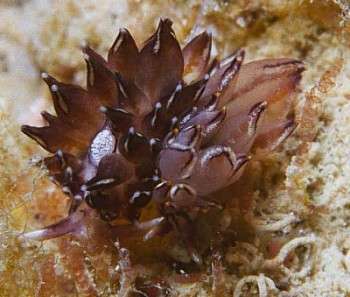
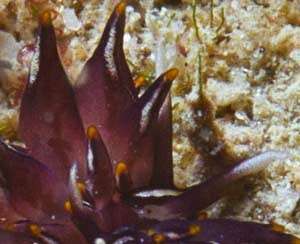
Hermaea zosterae
(Baba, 1959)
Order: SACOGLOSSA
Superfamily: LIMAPONTIOIDEA
Family: Hermaeidae
DISTRIBUTION
Japan.
PHOTO
Shima Pref. Mie, Japan (Kii Peninsula east coast). 15mm long, Jan. 2000, Depth: 3m. PHOTO: Yasuhiro Shirai.
Stiliger (Ercolania) zosterae Baba 1959 was described from a single 3mm long specimen.
"Rhinos auriculate, general color whitish. Head above marked with purple-red U-letter, the legs running up lower half of rhinos. Additional red-purple band on each side of head and runs down soide of body. Branchial papillae veined light olive green, tips chrome yellow - their surface ornamented with 3 longitudinal stripes of purple-red. Rhinophores tipped with opaque white. Found at Tomioka, Amakusa on Zostera" [Summary of original description].
It is most probably a species of Hermaea according to Kathe Jensen [see message below.]
Reference:
• Baba, K. (1959) The family Stiligeridae from Japan (Opisthobranchia-Sacoglossa). Publications of the Seto marine Biological Laboratory, 7(3): 327-336.
See message below.
Authorship detailsRudman, W.B., 2000 (February 27) Hermaea zosterae (Baba, 1959). [In] Sea Slug Forum. Australian Museum, Sydney. Available from http://www.seaslugforum.net/find/stilzost
Related messages
Hermaea noto and H. zosterae
May 21, 2002
From: Nishina Masayoshi
Dear Dr.Rudman,
This is old topic but I would like to return to the discussion concerning Juvenile aeolid from Hachijo Is. where we finally decided the animal was a juvenile of Hermaea zosterae.
I recently had a chance to see color plates of Hermaea noto (Baba, 1959) in the book "Opisthobranchs of Toyama Bay". The plates of Hermaea noto and a juvenile of Hermaea zosterae that we found in Hachijo look very similar. Are they are the same?
Best Regards,
Nishina Masayoshi
nishina@hpe15.wips.co.jp
Masayoshi, N., 2002 (May 21) Hermaea noto and H. zosterae. [Message in] Sea Slug Forum. Australian Museum, Sydney. Available from http://www.seaslugforum.net/find/5195Dear Nishina,
Thanks for this information. Both Stiliger (Ercolania) noto and Stiliger (Ercolania) zosterae were described by Baba (1959) in the same paper. They both have auriculate rhinophores and have blade shaped radular teeth so would today be considered species of Hermaea.
'Stiliger (Ercolania) noto' was described as growing to 5-10mm and having auriculate rhinophores. In colour, the entire animal almost black. The head marked by having 4 longitudinal bands of black, and a white patch in the median part and round each of the eyes. The pericardial prominence whitish. Branchial papillae black, the inner and outer edges towards the the end white, their tips yellowish brown.
'Stiliger (Ercolania) zosterae' was described from a single 3mm long animal. It was also described as having auriculate rhinophores. In colour, the head had a reddish U shaped mark and an additionals longitudinal line on each side. In most features the description certainly fits the photos in the Forum photo 1 photo 2 of supposedly juvenile H. zosterae.
On looking at the descriptions and the photos we now have available, I tend to think that H. noto and H. zosterae are the same species, H. zosterae being the juvenile colour form. It seems that the U shape on the head breaks into a pair of lines as the animal grows and its colour deepens from purple-red to black. If they do turn out to be the same I suggest H. noto should have precedence over H. zosterae since it is based on a number of specimens and appears on the page before H. zosterae in Baba (1959).
• Baba, K. (1959) The family Stiligeridae from Japan (Opisthobranchia-Sacoglossa). Publications of the Seto marine Biological Laboratory, 7(3): 327-336.
Any comments are very welcome.
Best wishes,
Bill Rudman
Re: Juvenile hermaeid from Hachijo Is., Japan
July 16, 2001
From: Nishina Masayoshi
Dear Dr.Rudman and Kathe R. Jensen,
I've got a email from Yasuhiro Shirai and he told me that this animal may be Hermaea zosterae which is already on the Forum. These two animals look almost
the same, especialy around the face and the renal sac.
Best Regards,
Nishina Masayoshi
nishina@hpe15.wips.co.jp
Nishina, M., 2001 (Jul 16) Re: Juvenile hermaeid from Hachijo Is., Japan . [Message in] Sea Slug Forum. Australian Museum, Sydney. Available from http://www.seaslugforum.net/find/4830Dear Nishina,
I think Yasuhiro Shirai is correct. How can such a small animal cause such a big confusion! When I look at your first photo it is crawling on Zostera, after which it was named, or a very similar green alga. I will move it to its correct page.
Best wishes,
Bill Rudman
Re: Juvenile aeolid from Hachijo Is., Japan
July 15, 2001
From: Kathe R. Jensen
Dear Bill and Nishina,
I am glad the old eyes can still spot a sacoglossan. However, I do not feel comfortable about assigning it to either Aplysiopsis or Hermaea. I guess this is another one who needs to have its teeth examined. Aplysiopsis has very characteristic "sabot-shaped" teeth with coarse denticles (sabot means a dutch wooden shoe - like those of Santa Claus), whereas Hermaea usually has blade-shaped teeth, sometimes with fine lateral denticles.
If this animal had had some large cerata, it might have been possible to see a branching vessel on the inner surface of the cerata. These vessels correspond to those seen in Elysia and connect to the pericardium.
Cheers,
Kathe
jensen@ait.ac.th
Jensen, K.R., 2001 (Jul 15) Re: Juvenile aeolid from Hachijo Is., Japan . [Message in] Sea Slug Forum. Australian Museum, Sydney. Available from http://www.seaslugforum.net/find/4820Thanks Kathe,
I think to be safe I will call it hermaeid sp. 1.
Cheers,
Bill Rudman
Re: Juvenile aeolid from Hachijo Is., Japan
July 14, 2001
From: Nishina Masayoshi
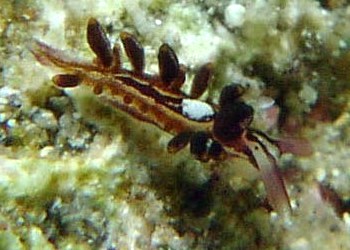
Dear Dr.Rudman and Kathe R. Jensen,
Thank you for your comments. Jun Imamoto has another good photo which I have attached here. I hope the photo helps. I thought the white area on the back is a sand grain or something but the animal in the attached image has the same white area on the back too. So this is may be something important.
Best Regards,
Nishina Masayoshi
nishina@hpe15.wips.co.jp
Nishina, M., 2001 (Jul 14) Re: Juvenile aeolid from Hachijo Is., Japan . [Message in] Sea Slug Forum. Australian Museum, Sydney. Available from http://www.seaslugforum.net/find/4817Dear Nishina,
I am glad you had another photo because it shows that Kathe Jensen's suggestion is correct. From this angle your animal is definitely a sacoglossan. The rhinophores are indeed enrolled and the white patch, which I also thought was a small coral piece, marks the renal sac.
It looks very like the animal on p41 of Atsushi Ono's book called "cf Aplysiopsis sp.". You can also see the prominent white mark in the small dorsal photo in the book.
Kathe if you can confirm that it is most probably a species of Aplysiopsis I will move it to its own page.
Best wishes,
Bill Rudman
Re: Juvenile aeolid from Hachijo Is., Japan
July 13, 2001
From: Kathe R. Jensen
Dear Bill,
I think I agree with Nishina that this species has a distinct sacoglossan appearance. To me the rhinophores look like they are rolled - at least at the base, and the position and size of the eye also looks sacoglossan. Also, I think the white area on the back is the renal sac, which has that chalk-white colour in many sacoglossans. The shape of the rhinophores would indicate Aplysiopsis, but I looked at Baba's descriptions of Japanese species, and could not find any to match. The other possiblity is one of those elusive Hermaea species, which seems to pop up at irregular intervals in different parts of the world - something like H. paucicirra, which has only been recorded from France and Spain. So this may be an undescribed species of Hermaea.
Cheers,
Kathe
jensen@ait.ac.th
Jensen, K.R., 2001 (Jul 13) Re: Juvenile aeolid from Hachijo Is., Japan. [Message in] Sea Slug Forum. Australian Museum, Sydney. Available from http://www.seaslugforum.net/find/4809Dear Kathe,
I guess we will never know. The position of the eyes is also characteristic of juvenile nudibranchs and to me the rhinophores don't look enrolled .. but that's just my guess.
Any other thoughts gratefully received
Best wishes,
Bill Rudman
Juvenile aeolid from Hachijo Is., Japan
July 12, 2001
From: Nishina Masayoshi
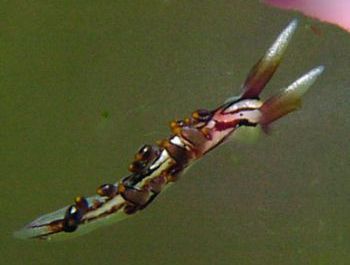
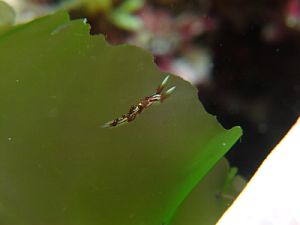
Dear Dr.Rudman,
Here is another of the small animals that my friend Mr.Jun Imamoto found and photographed on our recent visit [July 2001] to Hachijo Island, Izu-Islands, about 300 k south of Tokyo, Japan. They were found at 6-7M depth and were all around 5mm, long.
It is perhaps a kind of Aplysiopsis or Stiliger?
Best Regards,
Nishina Masayoshi
nishina@hpe15.wips.co.jp
Nishina, M., 2001 (Jul 12) Juvenile aeolid from Hachijo Is., Japan. [Message in] Sea Slug Forum. Australian Museum, Sydney. Available from http://www.seaslugforum.net/find/4743Dear Nishina,
I am pretty sure this is a very small juvenile of the aeolid Facelina quadrilineata. The shape of the rhinophores is much more nudibranch than a sacoglossan. In this animal they are proportionally much larger than in adults, but it is quite normal for juveniles to have large rhinophores. I guess if you have to smell your food from some distance then the larger your rhinophores the better your chance of not starving. Although I am pretty sure this is a juvenile, I can't of course be certain of its identity. However the arrangement of the cerata is quite facelinid and the colour pattern fits that of F. quadrilineata very well.
Best wishes,
Bill Rudman
Re: Identity of Stiliger zosterae
May 8, 2000
From: Kathe R. Jensen
Dear Bill,
I agree with your identification. However, I think Stiliger zosterae needs to be transferred to another genus, namely Hermaea. If you look closely at the rhinophores, you will see a short flap like the beginning of a bifid tip. This is seen in Aplysiopsis and Hermaea. Looking at Baba's original description of Stiliger zosterae, the radular teeth are short, stout, almost conical. When I first saw these teeth I guessed that this would be a diatom-feeder, like Hermaea vancouverensis, and I think this species is rather similar (though I have never seen it alive). So, to get a definite ID on this one, we will need to look at its radula.
Kathe Jensen.
jensen@ait.ac.th
Jensen, K.R., 2000 (May 8) Re: Identity of Stiliger zosterae. [Message in] Sea Slug Forum. Australian Museum, Sydney. Available from http://www.seaslugforum.net/find/2365Thanks Kathe,
Bill Rudman.
Identity of Aplysiopsis sp. 1.
February 27, 2000
From: Bill Rudman.
I think the identity of the animal I identified as Aplysiopsis sp. 1 for Yasuhiro Shirai is Stiliger zosterae Baba, 1959. I have summarised Baba's description on the above page. Any views welcome.
Bill Rudman.
Re: Aplysiopsis from Japan
February 18, 2000
From: Yasuhiro Shirai

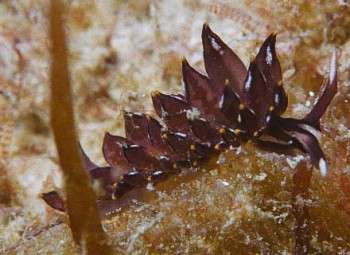
Dear Bill,
Thank you for your reply about my message. Here are photos of another specimen photographed at the same time.
Thankyou,
Yasuhiro
yasuhiro@e-net.or.jp
Shirai, Y., 2000 (Feb 18) Re: Aplysiopsis from Japan. [Message in] Sea Slug Forum. Australian Museum, Sydney. Available from http://www.seaslugforum.net/find/1928Dear Yasuhiro,
Thanks for the extra photos. I have a feeling I have seen a photo of this animal before but I'm afraid I can't find a reference to it.
Bill Rudman.
Aplysiopsis? from Japan
January 30, 2000
From: Yasuhiro Shirai
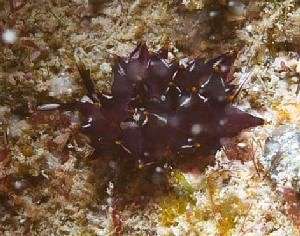

Dear Bill,
Thank you for your quick reply every time.
This time, I have attached 2 files.
I think this is Aplysiopsis sp. as found in Mr.Ono's opisthobranch guide book page -41.
What do you think about it?
Could you please identify this animal for me.
Data:
Location: Shima Pref. Mie Japan (Kii Peninsula east coast)
Length: 15mm
Water temperature: 13C
Date Jan. 2000
Depth: 3m
Crawling on sandy bottom.
Best regards,
Yasuhiro Shirai
http://www.e-net.or.jp/user/yasuhiro/
yasuhiro@e-net.or.jp
Shirai, Y., 2000 (Jan 30) Aplysiopsis? from Japan. [Message in] Sea Slug Forum. Australian Museum, Sydney. Available from http://www.seaslugforum.net/find/1784Dear Yasuhiro,
I am unfamiliar with this species. It could quite possibly be a species of Aplysiopsis but I am not sure. Perhaps a sacoglossan expert can help us.
Best wishes,
Bill Rudman.
